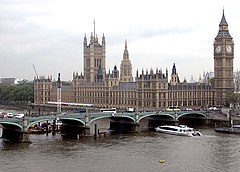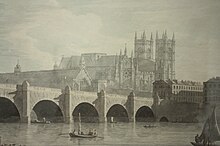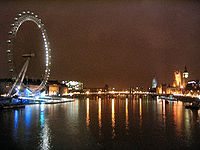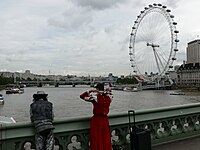Westminster Bridge: Difference between revisions
No edit summary |
|||
| (2 intermediate revisions by 2 users not shown) | |||
| Line 6: | Line 6: | ||
|picture=Westminster Bridge, River Thames, London, England.jpg | |picture=Westminster Bridge, River Thames, London, England.jpg | ||
|picture caption=Westminster Bridge and the Palace of Westminster | |picture caption=Westminster Bridge and the Palace of Westminster | ||
|os grid ref=TQ30467967 | |||
|latitude=51.500929 | |||
|longitude=-0.121867 | |||
|carries=A302 road | |carries=A302 road | ||
|crosses=River Thames | |crosses=River Thames | ||
| Line 13: | Line 16: | ||
|spans=7 | |spans=7 | ||
|length=820 feet | |length=820 feet | ||
|width= | |width=85 feet | ||
|open=24 May 1862 | |open=24 May 1862 | ||
|below= | |below= | ||
| Line 22: | Line 25: | ||
'''Westminster Bridge''' is a road and foot traffic bridge over the [[River Thames]] in London, linking [[Westminster]] in [[Middlesex]] on the north side to [[Lambeth]] in [[Surrey]] on the south side. | '''Westminster Bridge''' is a road and foot traffic bridge over the [[River Thames]] in London, linking [[Westminster]] in [[Middlesex]] on the north side to [[Lambeth]] in [[Surrey]] on the south side. | ||
The bridge is painted predominantly green, the same colour as the leather seats in the House of Commons which is on the side of the [[Palace of Westminster]] nearest to the bridge. This is in contrast to [[Lambeth Bridge]] which is red, the same colour as the seats in the House of Lords and is on the opposite side of the Houses of Parliament.<ref> | The bridge is painted predominantly green, the same colour as the leather seats in the House of Commons which is on the side of the [[Palace of Westminster]] nearest to the bridge. This is in contrast to [[Lambeth Bridge]] which is red, the same colour as the seats in the House of Lords and is on the opposite side of the Houses of Parliament.<ref>Becky Jones and Clare Lewis: 'The Bumper Book of London: Everything You Need to Know About London and More...' (Frances Lincoln, 2012) ISBN 978 1 781011 03 4 |page=127 |accessdate=2014-08-24}}</ref> | ||
In 2005–2007 the bridge underwent a complete refurbishment, including replacing the iron fascias and repainting the whole bridge. | In 2005–2007 the bridge underwent a complete refurbishment, including replacing the iron fascias and repainting the whole bridge. | ||
| Line 28: | Line 31: | ||
It links the Palace of Westminster on the west side of the river with [[County Hall, Lambeth|County Hall]] and the [[London Eye]] on the east and was the finishing point during the early years of the London Marathon. | It links the Palace of Westminster on the west side of the river with [[County Hall, Lambeth|County Hall]] and the [[London Eye]] on the east and was the finishing point during the early years of the London Marathon. | ||
The next bridge downstream is the [[Hungerford | The next bridge downstream is the [[Hungerford Bridge]] and upstream is [[Lambeth Bridge]]. Westminster Bridge was designated a Grade II* listed structure in 1981.<ref>{{NHLE|1081058|Westminster Bridge}}</ref> | ||
==History== | ==History== | ||
| Line 37: | Line 40: | ||
The bridge was required for traffic from the expanding [[West End of London|West End]] to the developing suburbs in northern [[Surrey]] as well as to south coast ports. Without the bridge, traffic from the West End would have to negotiate the congested routes to [[London Bridge]] such as the Strand and New Oxford Street. Roads south of the river were also improved, including the junction at the Elephant & Castle in [[Southwark]]. | The bridge was required for traffic from the expanding [[West End of London|West End]] to the developing suburbs in northern [[Surrey]] as well as to south coast ports. Without the bridge, traffic from the West End would have to negotiate the congested routes to [[London Bridge]] such as the Strand and New Oxford Street. Roads south of the river were also improved, including the junction at the Elephant & Castle in [[Southwark]]. | ||
By the mid 19th century the bridge was subsiding badly and expensive to maintain, and had to be replaced. The current bridge was designed by Thomas Page and opened on 24 May 1862.<ref> | By the mid 19th century the bridge was subsiding badly and expensive to maintain, and had to be replaced. The current bridge was designed by Thomas Page and opened on 24 May 1862.<ref>Eade, John: '[http://thames.me.uk/s00130.htm Where Thames Smooth Waters Glide]' - Thames.me.u</ref> With a length of 820 feet and a width of 85 feet,<ref>'[http://infrastructure.planningportal.gov.uk/wp-content/ipc/uploads/projects/WW010001/2.%20Post-Submission/Representations/23-09-2013%20-%20Applicant%27s%20submissions%20made%20for%20the%20deadline%20of%2023%20September%202013./9.15.60_Tunnel_and_Bridge_Assessments_Westminster_Bridge.pdf Tunnel and Bridge Assessments: Central Zone: Westminster Bridge]': Thames Tideway Tunnel, page 4 (Thames Water Utilities, September 2013)</ref> it is a seven-arch wrought iron bridge with Gothic detailing by Charles Barry (the architect of the [[Palace of Westminster]]). It is the oldest road bridge across the Thames in central London. | ||
<gallery> | <gallery> | ||
Latest revision as of 19:35, 8 March 2020
| Westminster Bridge | |
| Middlesex, Surrey | |
|---|---|
 Westminster Bridge and the Palace of Westminster | |
| Location | |
| Carrying: | A302 road |
| Crossing: | River Thames |
| Location | |
| Grid reference: | TQ30467967 |
| Location: | 51°30’3"N, 0°7’19"W |
| Structure | |
| Length: | 820 feet |
| Design: | Arch bridge |
| History | |
| Built 1862 | |
| Information | |

Westminster Bridge is a road and foot traffic bridge over the River Thames in London, linking Westminster in Middlesex on the north side to Lambeth in Surrey on the south side.
The bridge is painted predominantly green, the same colour as the leather seats in the House of Commons which is on the side of the Palace of Westminster nearest to the bridge. This is in contrast to Lambeth Bridge which is red, the same colour as the seats in the House of Lords and is on the opposite side of the Houses of Parliament.[1]
In 2005–2007 the bridge underwent a complete refurbishment, including replacing the iron fascias and repainting the whole bridge.
It links the Palace of Westminster on the west side of the river with County Hall and the London Eye on the east and was the finishing point during the early years of the London Marathon.
The next bridge downstream is the Hungerford Bridge and upstream is Lambeth Bridge. Westminster Bridge was designated a Grade II* listed structure in 1981.[2]
History
For over 600 years, London Bridge was the only bridge over the Thames below that at Kingston. A bridge at Westminster was proposed in 1664, but opposed by the Corporation of London and the watermen. Eventually in 1729 a new timber bridge was built at Putney, but it took until 1736 before Parliamentary approval was given for another, at Westminster. The new bridge was financed by private capital, lotteries and grants, and designed by the Swiss architect Charles Labelye. It took eleven years to build, between 1739 and 1750.
The City of London responded to Westminster Bridge by removing the buildings on London Bridge and widening it in 1760–63. The City also began work on the Blackfriars Bridge, which opened in 1769. Other bridges from that time include Kew Bridge (1759), Battersea Bridge (1773), and Richmond Bridge (1777).
The bridge was required for traffic from the expanding West End to the developing suburbs in northern Surrey as well as to south coast ports. Without the bridge, traffic from the West End would have to negotiate the congested routes to London Bridge such as the Strand and New Oxford Street. Roads south of the river were also improved, including the junction at the Elephant & Castle in Southwark.
By the mid 19th century the bridge was subsiding badly and expensive to maintain, and had to be replaced. The current bridge was designed by Thomas Page and opened on 24 May 1862.[3] With a length of 820 feet and a width of 85 feet,[4] it is a seven-arch wrought iron bridge with Gothic detailing by Charles Barry (the architect of the Palace of Westminster). It is the oldest road bridge across the Thames in central London.
-
The first Westminster Bridge as painted by Canaletto, 1746
-
Westminster Bridge, around 1750. The proprietors of the bridge had to pay compensation to the operators of the earlier 'Horseferry', and to local watermen
-
Westminster & Lambeth, 1746. Westminster Bridge, opened in 1740, connects Westminster to Lambeth; Huntley Ferry crosses the river on the site of the future Vauxhall Bridge
-
The Burning of the Houses of Lords and Commons by J. M. W. Turner, 1835, with Westminster Bridge on the right
-
Street lamps on the bridge
In popular culture


William Wordsworth wrote the sonnet Composed upon Westminster Bridge, 3 September 1802.
Earth hath not anything to show more fair:
Dull would he be of soul who could pass by
A sight so touching in its majesty:
This City now doth, like a garment, wear
The beauty of the morning; silent, bare,
Ships, towers, domes, theatres and temples lie
Open unto the fields, and to the sky;
All bright and glittering in the smokeless air.
In modern times the bridge has frequently been used as a set or a backdrop on film and television: the Palace of Westminster behind it is an unmistakable geographical tag.
In the film Genevieve the characters race their veteran cars from Brighton to London with Westminster Bridge as the finish line
In the television series Doctor Who, Westminster Bridge has frequently been used for various location shots, first in 1964 in the serial The Dalek Invasion of Earth which depicts the structure as desolate and deserted as the Daleks glide across it: quite a contrast to it usual state, packed with commuters and tourists. The location was then re-used several times in later series.
The same theme was used in the 2002 horror film 28 Days Later, the protagonist awakes from a coma to find London deserted, and walks over an eerily empty Westminster Bridge whilst looking for signs of life.
To list all the appearances of Westminster Bridge on film or in television would take volumes.
Westminster Bridge is the start and finish point for the Bridges Handicap Race, a traditional London running race.
Outside links
| ("Wikimedia Commons" has material about Westminster Bridge) |
References
- ↑ Becky Jones and Clare Lewis: 'The Bumper Book of London: Everything You Need to Know About London and More...' (Frances Lincoln, 2012) ISBN 978 1 781011 03 4 |page=127 |accessdate=2014-08-24}}
- ↑ National Heritage List 1081058: Westminster Bridge
- ↑ Eade, John: 'Where Thames Smooth Waters Glide' - Thames.me.u
- ↑ 'Tunnel and Bridge Assessments: Central Zone: Westminster Bridge': Thames Tideway Tunnel, page 4 (Thames Water Utilities, September 2013)
| Bridges and crossings on the River Thames | ||||||
|---|---|---|---|---|---|---|
| Grosvenor Bridge | Vauxhall Bridge | Lambeth Bridge | Westminster Bridge | Hungerford Bridge | Waterloo Bridge | Blackfriars Bridge |





